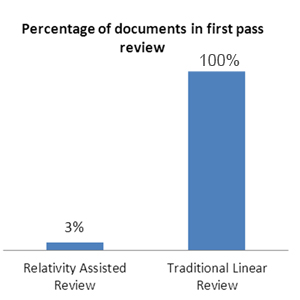Teaching computers new tricks
Law In Order is helping lawyers and computers to work in harmony on large scale litigation, writes Sam Lamble.

Law In Order is helping lawyers and computers to work in harmony on large scale litigation, writes Sam Lamble.
To continue reading the rest of this article, please log in.
Create free account to get unlimited news articles and more!
The use of statistical analysis to reveal the meaning of documents – also known as Computer Assisted Review - is part of an ongoing and ever refining set of principles that are helping computers to learn.
This technology is currently deployed in many ways, from Google’s predictive searching, identification of cheating in student assignments and by spy agencies to monitor ‘chatter’ and determine what is being spoken about.
In the sense of a legal review, it is also an integral tool in dealing with the exponential increase in document review and is being harnessed in a number of ways, as can be seen on a recent matter where I provided technology support on a case relating to a large energy company that was involved in litigation over an environmental matter.
The power of one
Only one lawyer was assigned to the case, overseen by one independent consultant—an especially small team, given the 778 GB of data (6.6 million documents in total) collected for the case.
In an effort to save costs, both sides agreed on a list of keywords to help identify relevant documents.
De-duplication and keyword searching culled the client’s original count of 6.6 million documents to a much more manageable 157,000 documents. However, with overly inclusive keywords like ‘environment’ being used, it was evident there were still many non-responsive documents left in the collection to sort out.
Using simple estimates to gauge time and the cost of a traditional review, I calculated that with the review of 100 documents an hour by a junior lawyer billing out at $200 per hour, the expected cost would be approximately $314,000 and would take about 1570 man hours to complete. The client said that this would not be based on time and cost.
The Assisted Review process
Law In Order proposed using RAR, Relativity’s Assisted Review technology. Initially, the 157,000 documents were loaded and a random sample of approximately 1,000 documents was reviewed for relevance by the lawyer.
This process was repeated another three times to train the software on responsive versus non-responsive. For each round, six to seven percent of the documents were identified as responsive.
From here, the lawyers ran a Q&A round to check RAR’s accuracy in predicting the responsiveness of the documents in the rest of the database. By taking a statistical sample based on a 95 per cent confidence level and a two percent margin of error, it was deemed that the results were consistent.
Achieving the results
In addition to the consistent results the lawyer only disagreed with the call made by RAR on a small number of documents. What was most interesting was that he actually changed his original decision to match that of the RAR the majority of the time.
With this realisation and the already low overturn rate in mind, the lawyer felt the computer had achieved a consistent level of accuracy for this case—even after just one Q&A round—and decided to stop the review.
Using Assisted Review, the lawyer was able to complete the first pass review in 10 days and the entire production in approximately a month.
This was a great example of the overwhelming cost and time saving for the client using the Computer Assisted Review Software. It was even more amazing that we all were confident with the software before it was confident with us.
Sam Lamble is a solutions consultant at Law In Order.
Copy and logo supplied by Law In Order. For more information,
go to www.lawinorder.com.au






